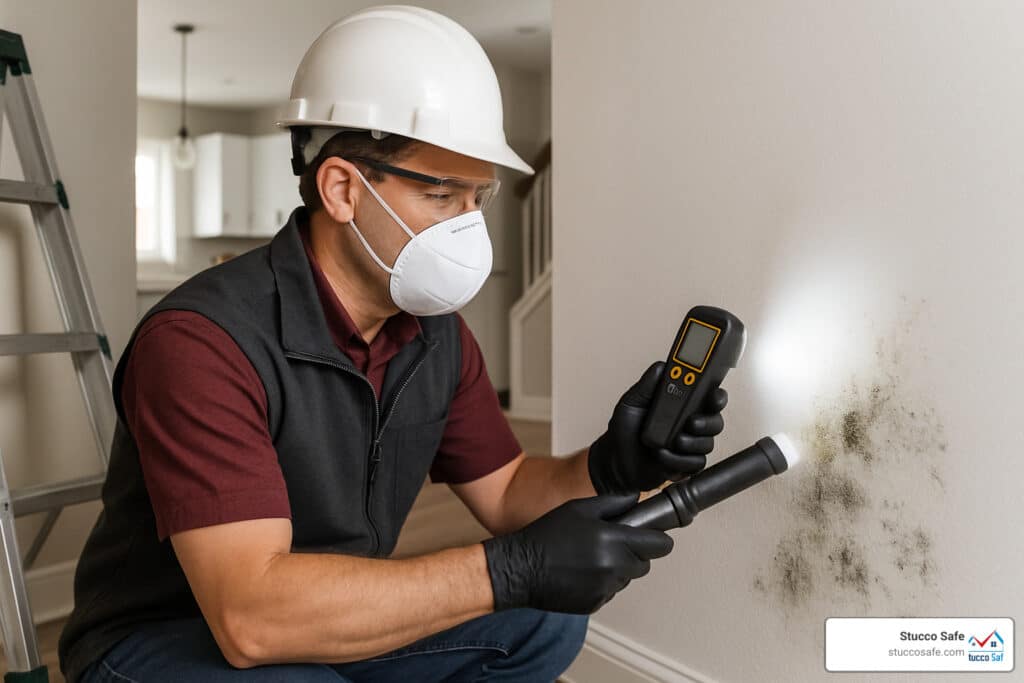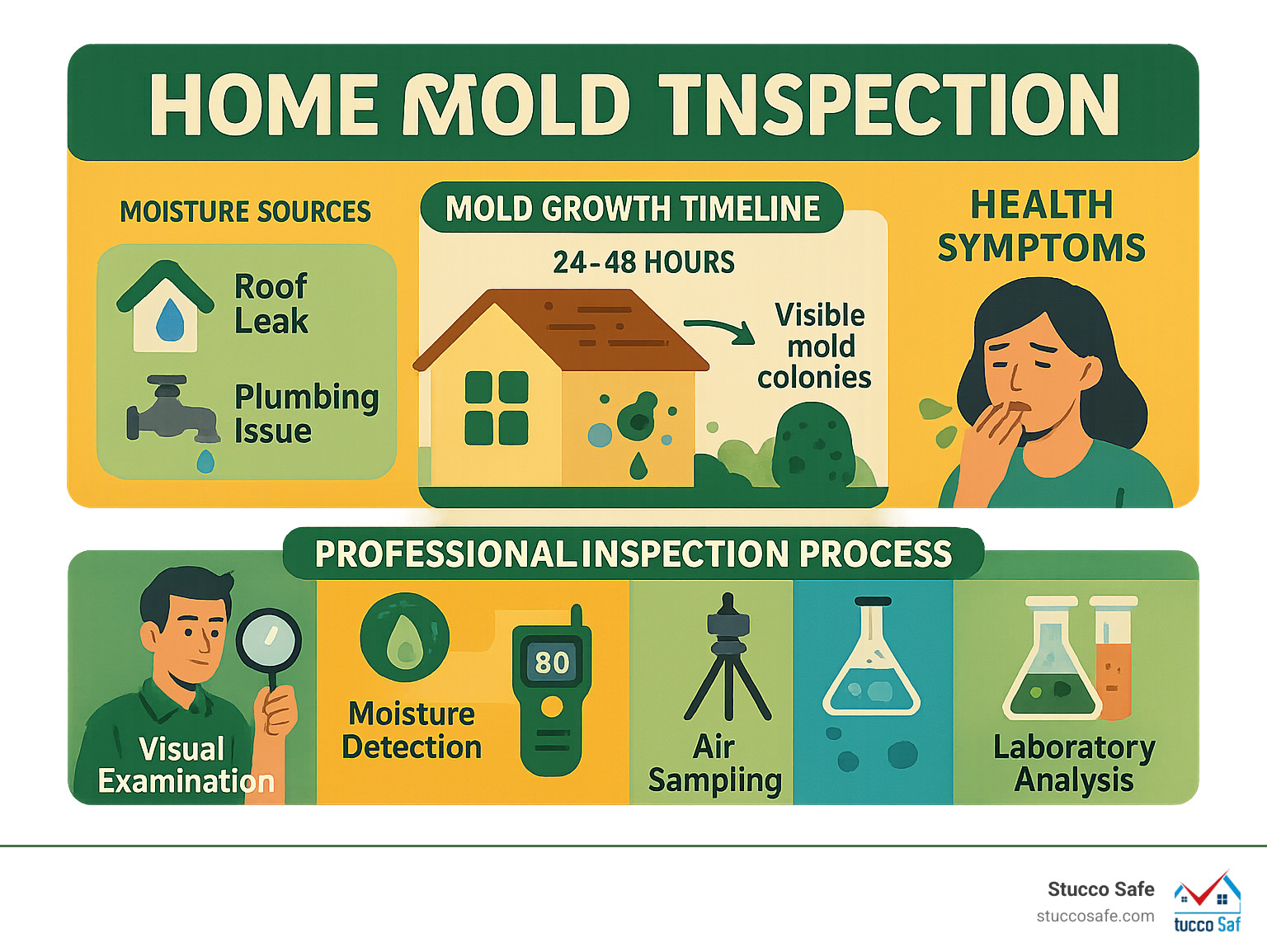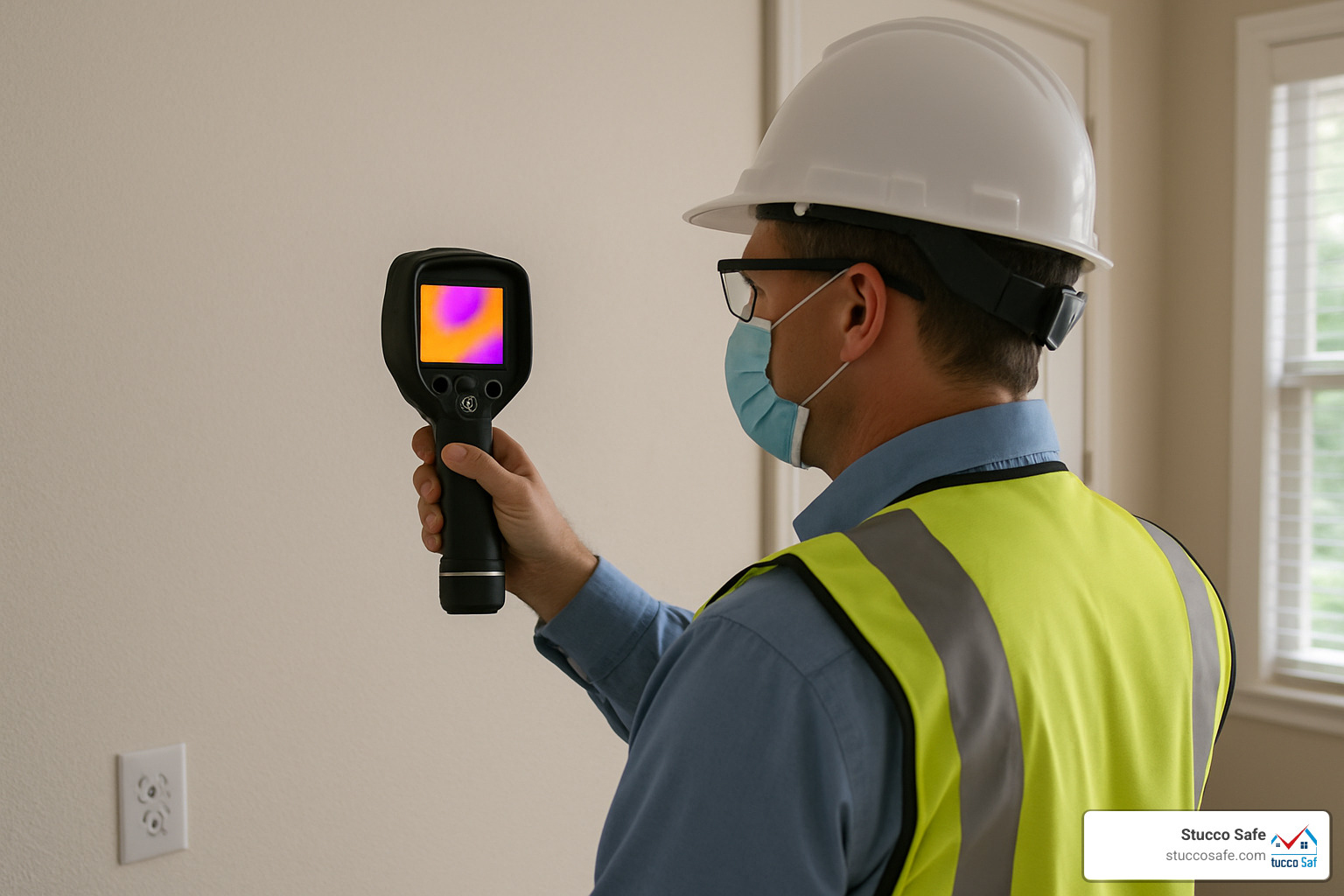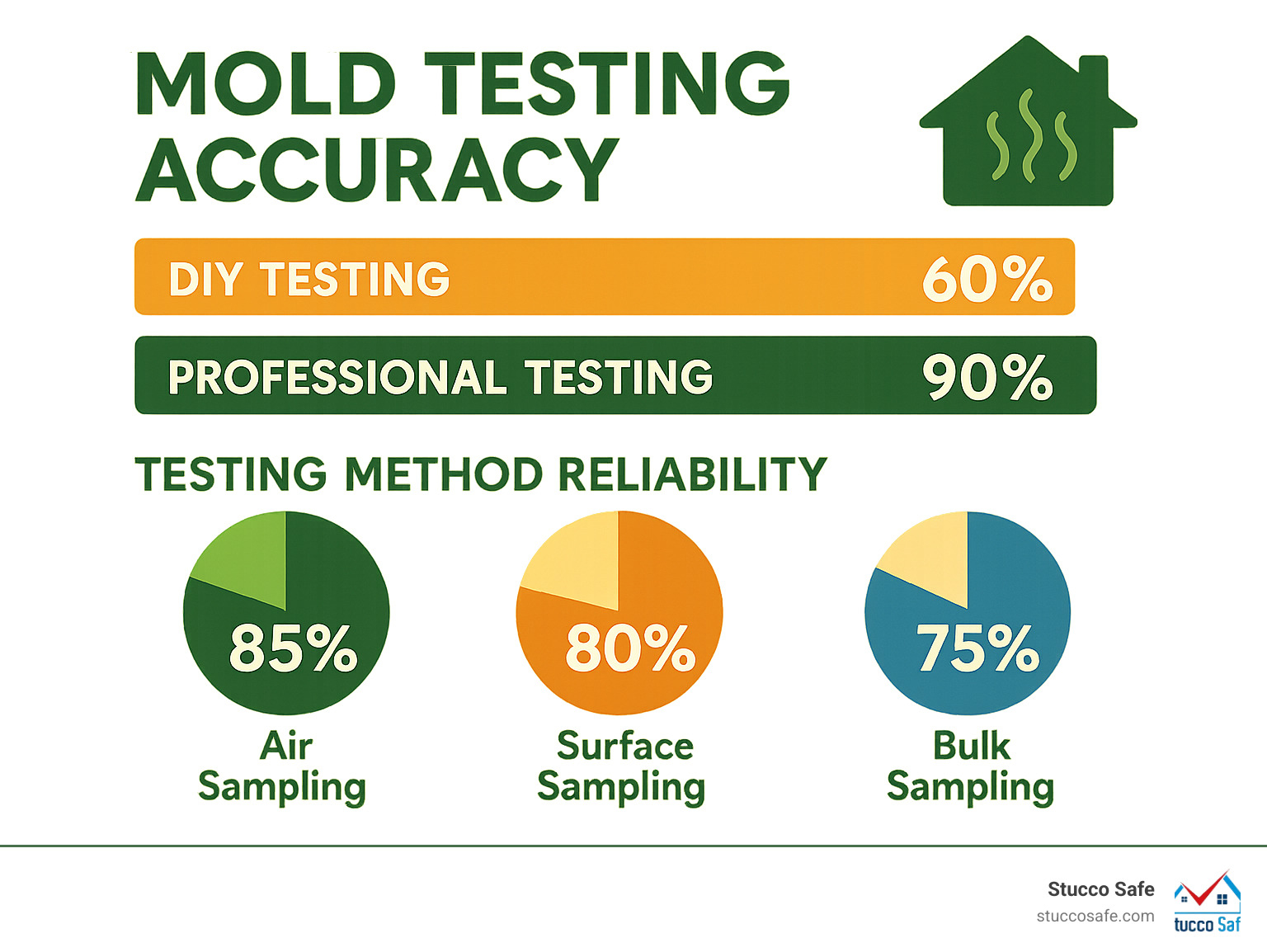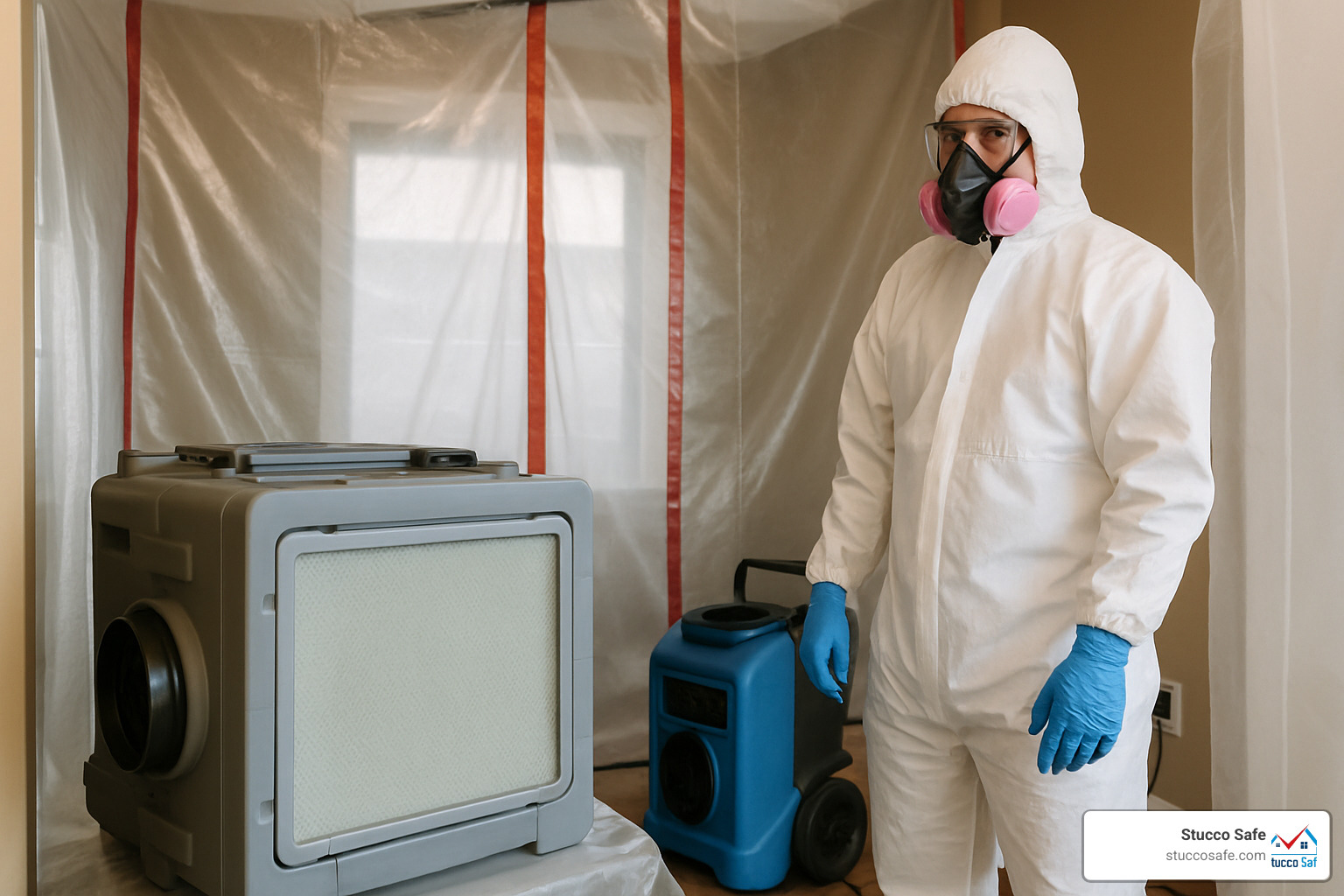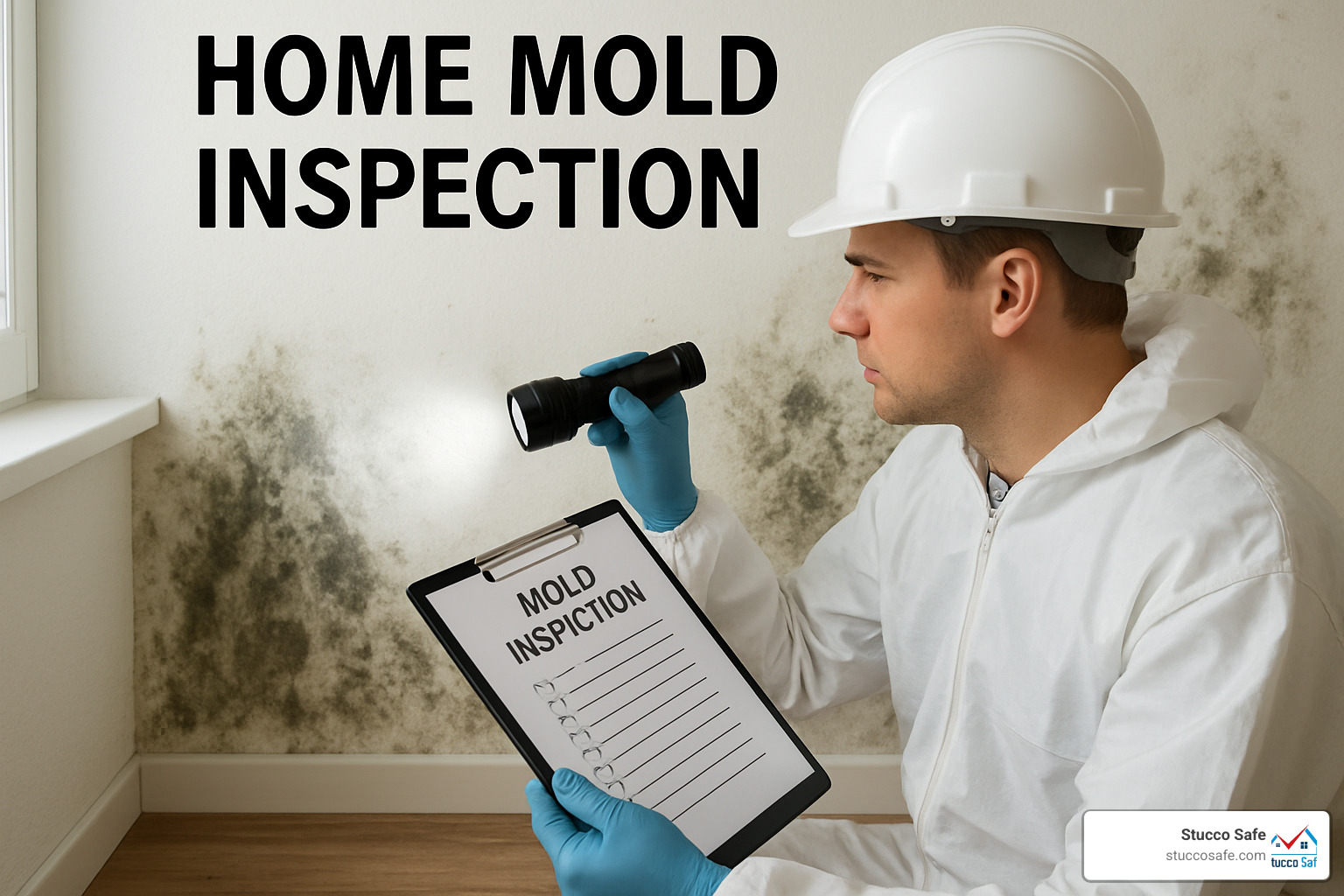Home Mold Inspection: 7 Must-Know Warning Signs in 2025
Why Home Mold Inspection Is Your First Line of Defense
Home mold inspection is a professional assessment that identifies visible and hidden mold growth in your property through visual examination, moisture detection, and laboratory testing. Here’s what you need to know:
When to Schedule an Inspection:
– Musty odors or visible mold spots
– After water damage or flooding
– Unexplained respiratory symptoms
– Before buying or selling a home
– Humidity levels consistently above 60%
What’s Included:
– Visual inspection of all areas
– Moisture detection with specialized tools
– Air and surface sampling
– Laboratory analysis
– Detailed report with recommendations
Average Costs:
– Small to medium homes (under 4,000 sq ft): $300-$400
– Larger homes: $700-$900
– Laboratory results: 24-48 hours
Mold can begin growing within just 24 to 48 hours after moisture exposure. What starts as a small leak behind a wall can quickly spread throughout your home, causing structural damage and health problems for your family.
“Nobody wants to know that they have mold in their home, but catching it early means addressing the problem before it gets worse,” according to industry experts. The key is understanding that one in three people have had an allergic reaction to mold, making professional detection crucial for protecting your family’s health.
I’m Gabe Kesslick, and I’ve been investigating moisture intrusion and building envelope issues since 2001, including extensive experience with home mold inspection in stucco and traditional construction. My forensic approach helps homeowners identify hidden moisture sources that lead to mold growth before they become expensive problems.
Home mold inspection vocabulary:
– home inspection basement moisture
– how do you test for mold in your home
– how to detect mold in your home
What Is Mold & Why It Matters
Think of mold as nature’s recycling crew – but one you definitely don’t want working inside your home. Mold is a type of fungus that spreads by releasing microscopic spores into the air. These tiny hitchhikers float invisibly through your house, waiting to land on the right spot to set up camp.
Mold needs just three things to thrive: moisture, air, and something organic to munch on. Unfortunately, our homes are like all-you-can-eat buffets for mold – wood framing, drywall, carpets, and even dust provide plenty of food sources.
Here’s what makes mold particularly sneaky: it loves to grow in hidden spaces where you can’t see it. Behind walls, under flooring, in crawl spaces, and inside HVAC systems – anywhere moisture accumulates without your knowledge. By the time you notice that telltale musty smell, the problem has often spread far beyond what meets the eye.
Moisture is the real driver of mold growth, which is why scientific research on mold health consistently points to moisture control as your best defense. Without moisture, mold simply can’t establish itself and multiply.
The structural damage potential shouldn’t be underestimated either. As mold feeds on organic materials, it literally breaks them down. We’ve seen cases where extensive mold growth compromised wood framing and required major structural repairs costing homeowners tens of thousands of dollars.
What’s truly concerning is mold’s timeline – it can begin growing within 24 to 48 hours after moisture exposure and spread throughout a building in just a few days once conditions are right.
Health Risks Linked to Indoor Mold
Mold doesn’t just sit quietly – it actively produces allergens, irritants, and sometimes mycotoxins (toxic substances that can cause health problems even in small amounts).
You might notice respiratory symptoms first: nasal stuffiness, throat irritation, persistent coughing, or wheezing. Many people also experience eye irritation, skin rashes, headaches, and unexplained fatigue.
If someone in your family has asthma, mold exposure can make their symptoms significantly worse. Certain groups face higher risks from mold exposure. Infants and elderly family members are particularly vulnerable, as are people with existing allergies or compromised immune systems.
Here’s what makes mold-related illness tricky: the symptoms often mimic other common conditions. This is exactly why a professional home mold inspection becomes crucial when unexplained health symptoms coincide with moisture problems.
Common “Red Flags” of Mold at Home
Learning to spot mold’s warning signs early can save your family’s health and your wallet. These red flags often appear before you actually see mold growth.
Musty odors are usually your first clue. That distinctive earthy, damp smell – especially in basements, bathrooms, or poorly ventilated areas – often signals hidden mold growth.
Water stains tell a story of moisture intrusion. Those discolored patches on walls, ceilings, or floors indicate past or ongoing water problems. Even after surfaces appear to dry out, mold may continue growing in hidden spaces.
Condensation issues create perfect mold conditions. Windows that regularly fog up, water droplets forming on walls, or consistently high humidity levels (above 60%) are like rolling out the welcome mat for mold spores.
Watch for warped building materials too. Wood that’s twisted or bowed, drywall that feels soft, and flooring that’s buckling all suggest moisture problems that likely involve mold growth.
Finally, peeling paint or wallpaper often indicates moisture getting behind wall coverings, creating ideal conditions for mold to flourish unseen.
Home Mold Inspection 101: When, Why & How
There comes a moment in every homeowner’s journey when you realize something isn’t quite right. Maybe it’s that persistent musty smell in the basement, or perhaps your family’s been dealing with unexplained sniffles. These are the moments when a home mold inspection becomes essential.
The decision to call in a professional typically happens after specific triggers. Post-flood situations demand immediate attention because mold can establish itself within 24-48 hours of water exposure. Even if you’ve dried everything you can see, moisture has a sneaky way of hiding in wall cavities and under flooring.
Real estate transactions represent another critical time for professional assessment. Whether you’re buying or selling, nobody wants surprises lurking behind the walls. I’ve seen buyers save thousands by finding hidden mold problems before closing.
When unexplained illness strikes multiple family members – especially respiratory symptoms that mysteriously improve when everyone leaves the house – it’s time to consider that your home’s air quality might be the culprit.
Signs You Need a Home Mold Inspection
Recognizing when you need a home mold inspection isn’t always obvious. Visible mold colonies might seem like a dead giveaway, but what you can see is often just a fraction of the problem. Professional assessment reveals the full extent of growth and identifies hidden colonies.
Humidity levels consistently above 60% create a mold paradise. If your home feels like a tropical greenhouse year-round, mold is probably already making itself comfortable somewhere.
Past water damage deserves special attention, even if previous leaks were supposedly “properly” handled. Water has a talent for penetrating building materials where mold can grow completely undetected. Our How to Detect Mold in Your Home guide provides detailed information on identifying these problems.
HVAC system concerns become apparent when musty odors greet you every time the heating or cooling kicks in. If you notice visible growth around vents or ductwork, your home’s air distribution system might be spreading contamination throughout every room.
Preparing for a Home Mold Inspection
Getting ready for a home mold inspection requires counterintuitive thinking. Your natural instinct might be to clean everything spotless, but that’s exactly what you shouldn’t do. The goal is preserving natural conditions that reveal the true extent of any mold problem.
Starting 24-48 hours before the inspection, shut off humidifiers, dehumidifiers, and air purification systems. Close all doors and windows, and resist the urge to clean with disinfectants. Skip outdoor activities like mowing that could affect outdoor baseline readings.
On inspection day, turn off your HVAC system at least 2 hours before we arrive. Avoid bathing or showering for 12 hours prior, and clear access to all potential problem areas. Try to schedule for a day with no rain in the forecast.
These preparations might feel strange, but they’re essential for accurate results. Running air filtration systems or cleaning can temporarily reduce spore counts, potentially masking a real problem.
Qualifications & Certifications to Look For
Since the EPA doesn’t certify mold inspectors, choosing qualified professionals requires understanding industry certifications. IAC2 (Indoor Air Quality Association) provides comprehensive mold assessment training and certification.
State licensing varies by location, with some states requiring specific mold assessor licenses. Look for inspectors who maintain continuing education in evolving industry standards.
Insurance coverage protects both you and the inspector, while AIHA-accredited laboratories ensure your samples receive proper analysis. Watch out for major red flags: inspectors who also offer remediation services create a conflict of interest, while extremely low prices often indicate corner-cutting.
Typical Cost & Timeframe
Home mold inspection costs reflect the complexity and importance of the work involved. For most homes under 4,000 square feet, expect to invest $300-$400 on average. Larger homes typically range from $700-$900.
The inspection process takes 2-6 hours depending on your property’s size. Laboratory analysis typically requires 24-48 hours, though some labs offer expedited results for additional fees when time is critical.
Professional inspection represents wise investment in early detection. Catching problems before they spread extensively can save you significant money and protect your family’s health.
Professional Mold Testing & Tools of the Trade
When you hire a professional for home mold inspection, you’re getting access to sophisticated tools and expertise that go far beyond what’s visible to the naked eye. The process starts with a thorough visual examination, but that’s just the beginning.
Modern inspection tools have revolutionized how we detect hidden problems. Moisture meters let us check the water content inside walls and floors without tearing anything apart. Thermal imaging cameras reveal temperature differences that indicate moisture problems – things completely invisible to the human eye.
Borescopes allow us to peek inside wall cavities, ductwork, and other tight spaces where mold loves to hide. Air sampling equipment collects microscopic spores floating in your indoor air for laboratory analysis.
At Stucco Safe, our forensic approach means we don’t just look for mold – we investigate why it’s there in the first place. Finding the moisture source is often more important than finding the mold itself.
Difference Between Inspection & Testing
Many homeowners get confused about whether they need a mold inspection, mold testing, or both. A mold inspection is like getting a physical exam – we look at your entire property, identify problem areas, and find moisture sources. Mold testing is like getting blood work done – it involves collecting samples for detailed laboratory analysis.
| Aspect | Inspection | Testing |
|---|---|---|
| Purpose | Identify problems and sources | Quantify and identify species |
| Cost | Lower | Higher |
| Time Required | 2-6 hours | Additional 24-48 hours for lab results |
| When Needed | Always recommended | Situational |
Testing isn’t always necessary. If we can see extensive mold growth during inspection, you probably don’t need expensive laboratory analysis. However, testing becomes valuable when we suspect hidden mold growth, when family members have unexplained health symptoms, or when you need documentation for insurance claims.
Types of Mold Tests Explained
Air sampling is the most common approach – we collect airborne spores and compare indoor concentrations to outdoor levels. Results can change dramatically based on weather conditions and HVAC operation, which is why we always collect outdoor samples for comparison.
Surface sampling uses tape lifts or swabs to collect samples directly from suspected growth areas. This method is more reliable for detecting localized problems.
ERMI testing represents the cutting edge of mold detection. This DNA-based analysis examines dust samples for 36 specific mold species associated with water damage. It’s more comprehensive but significantly more expensive.
Our Mold Safe Mold Testing approach always includes outdoor baseline sampling. Without this comparison, indoor results are nearly meaningless.
DIY Kits vs. Pro Labs
DIY mold test kits promising professional results for under $50 come with significant limitations. DIY kits simply can’t provide the accuracy and reliability of professional testing. They lack proper quality control and provide no expert interpretation of results.
Professional testing offers AIHA-accredited laboratory analysis with proper sampling protocols. More importantly, you get expert interpretation that puts results in context and provides actionable recommendations.
Our Home Mold Test combines professional sampling with comprehensive moisture assessment. DIY kits might be appropriate for initial screening, but never make health decisions based solely on DIY results.
Limitations & Regulations
There are no federal standards for acceptable indoor mold levels. Unlike other air pollutants, the EPA hasn’t established threshold concentrations that define “safe” versus “unsafe” mold exposure.
This means interpreting test results requires expertise and judgment. Results can vary dramatically based on weather conditions, HVAC operation, and sampling timing. The EPA’s position, outlined in their scientific research on sampling limits, emphasizes focusing on moisture control rather than relying heavily on numerical test results.
State regulations for mold assessment vary dramatically. Some states require specific licensing, while others have no regulations at all. Professional standards from organizations like IAC2 and AIHA provide guidelines for proper sampling when followed by qualified professionals.
The key is working with experienced professionals who understand these limitations. Testing is a tool, not a magic answer – it works best when combined with thorough inspection and moisture assessment.
From Results to Remediation & Prevention
When your home mold inspection is complete, you’ll receive a comprehensive report that becomes your roadmap for addressing any issues. This includes moisture readings, visual observations, laboratory results, and most importantly, specific recommendations for fixing the underlying problems.
Here’s what many homeowners don’t realize: simply cleaning visible mold without fixing the moisture source is like putting a band-aid on a broken pipe. The mold will return because the conditions that allowed it to grow haven’t changed.
The most critical step after any positive mold results is addressing the moisture source immediately. Whether it’s a leaky roof, faulty plumbing, or poor ventilation, that underlying problem must be fixed before any cleaning begins.
Immediate actions after positive results include stopping any active leaks, isolating affected areas to prevent spore spread, and avoiding disturbing moldy materials without proper containment.
Next Steps After Positive Results
The scope of remediation depends entirely on what your inspection revealed. Small areas of surface mold (less than 10 square feet) might be manageable with careful DIY cleaning, but larger infestations require professional intervention.
Professional remediation follows a specific process designed to eliminate mold while preventing its spread. The process begins with containment – sealing off affected areas and creating negative air pressure. Workers use full protective equipment because disturbing mold releases massive amounts of spores.
The actual removal involves carefully removing contaminated materials and disposing of them properly. Porous materials like drywall often can’t be saved, while non-porous surfaces can usually be cleaned with antimicrobial solutions.
One crucial point: never hire the same company for both inspection and remediation. This creates a conflict of interest. Some states actually require this separation by law.
Post-remediation verification is essential but often overlooked. Always insist on clearance testing by an independent assessor after remediation is complete.
Ongoing Moisture Control & Prevention
The best mold remediation is preventing mold from growing in the first place. Since mold can establish itself within 24-48 hours of moisture exposure, your prevention strategy needs to focus on controlling humidity and responding quickly to water problems.
Humidity control forms the foundation of mold prevention. Indoor humidity should stay between 30-50% year-round. Dehumidifiers help during humid months, while proper ventilation prevents moisture buildup in bathrooms, kitchens, and laundry areas.
Ventilation systems need regular attention. Bathroom and kitchen exhaust fans should vent directly outside, not into attics where moisture will cause problems elsewhere.
Exterior maintenance plays a huge role in preventing moisture intrusion. Keep gutters clean and directed away from your foundation. Address roof leaks immediately. Ensure proper grading so water flows away from your home.
For stucco homes, moisture control requires special attention. Our Mold Inspection in Stucco Homes guide addresses specific moisture intrusion patterns in stucco construction.
Long-Term Monitoring & Maintenance
Mold prevention requires ongoing vigilance and regular maintenance. Annual maintenance should include inspecting HVAC systems, checking weatherstripping, and cleaning exhaust fans. Don’t forget basement and crawl space areas where moisture problems often develop unnoticed.
Smart technology can provide early warning of developing moisture problems. Modern humidity sensors can alert you to humidity spikes that indicate potential moisture intrusion.
Insurance considerations become important if you’ve had previous mold problems. Document all moisture issues and remediation efforts. Understanding your policy and maintaining proper documentation can save thousands if problems develop.
Regular professional inspections provide peace of mind, especially for homes with previous moisture problems. The cost of prevention is always less than the cost of remediation.
Frequently Asked Questions about Home Mold Inspection
How long does it take to get mold test results?
When you’re waiting for home mold inspection results, most laboratory analysis takes just 24-48 hours once your samples reach the lab. Standard air and surface samples from AIHA-accredited laboratories typically come back within 2 business days.
Need results faster? Many labs offer expedited processing for time-sensitive situations like real estate closings. You’ll pay about 50-100% more, but you can get results the next day.
ERMI testing takes longer – usually 5-7 business days because it’s a more complex DNA-based analysis.
Can I skip testing if I already see mold?
Sometimes you absolutely can skip testing. If you’ve got extensive visible mold growth covering large areas, testing won’t change the fact that you need professional remediation. Same goes for small areas under 10 square feet that you can safely clean yourself.
But what you see might not be everything you’ve got. That patch of mold on your bathroom wall could be the tip of the iceberg.
Testing becomes valuable when you need to understand the full scope of the problem, when family members are having respiratory issues, or for real estate transactions and insurance claims.
The bottom line? If you’re dealing with obvious, extensive mold growth, jump straight to remediation. But if you’re seeing limited growth, have health concerns, or need documentation, testing provides valuable information.
Are there acceptable indoor mold levels?
This might surprise you, but there are no EPA-established “safe” levels for indoor mold. People react differently to mold exposure, and outdoor mold levels change constantly based on weather and seasons.
Instead of looking at absolute numbers, professionals use comparative analysis. We compare your indoor levels to what’s happening outside your home. Generally, indoor concentrations should be similar to or lower than outdoor levels.
The species matter too. Finding the same types of mold indoors that are common outdoors is usually less concerning than finding species that indicate water damage problems.
The most important point: focus on symptoms and moisture control, not just numbers. If people in your home are experiencing mold-related health issues, you may need remediation regardless of spore counts.
At Stucco Safe, we’ve learned that the most meaningful question isn’t “How much mold is too much?” but rather “What’s causing the mold, and how do we fix the underlying problem?”
Conclusion
When it comes to protecting your family’s health and your home’s value, home mold inspection isn’t just another item on your maintenance checklist—it’s your best defense against a problem that can spiral out of control faster than you might think.
We’ve covered a lot of ground together in this guide, from understanding how mold can take hold in just 24 to 48 hours to learning when professional testing makes sense and when you might be able to skip it. The bottom line is simple: moisture is the enemy, and knowledge is your weapon.
Think of it this way—you wouldn’t ignore a strange noise from your car’s engine or dismiss chest pains as “probably nothing.” The same logic applies to musty odors, water stains, or that nagging feeling that something’s not quite right with your indoor air quality. Your instincts are usually trying to tell you something important.
Professional assessment matters because what you can see is often just the tip of the iceberg. That small patch of discoloration on your basement wall might be connected to a much larger moisture problem hiding behind drywall or under flooring. Our forensic approach at Stucco Safe has uncovered countless hidden moisture sources that would have eventually led to expensive structural damage and health problems.
The focus on moisture control can’t be overstated. You can clean visible mold all day long, but if you don’t fix the leak, improve the ventilation, or address the humidity problem, you’re just buying time. It’s like mopping the floor while the faucet is still running—frustrating and ultimately futile.
For homeowners in Southeastern Pennsylvania, New Jersey, and Delaware, we understand the unique challenges that our climate and construction methods can present. Stucco homes, in particular, require specialized knowledge to identify moisture intrusion patterns that can lead to serious mold problems.
Whether you’re dealing with suspicious smells, planning a home purchase, or family members are experiencing unexplained respiratory symptoms, home mold inspection provides the clarity you need to make informed decisions. The peace of mind that comes from knowing your home’s true condition is invaluable.
Don’t let a small moisture problem become tomorrow’s major headache. Our certified inspectors use advanced thermal imaging and moisture detection equipment to give you the complete picture. We serve communities throughout our region, from Philadelphia to West Chester to Cherry Hill, helping homeowners protect what matters most.
Ready to take the next step? Contact our moisture-detection experts today. Because when it comes to mold, what you don’t know really can hurt you—and your wallet.
Your home should be your safe haven, not a source of worry. Let’s make sure it stays that way.

